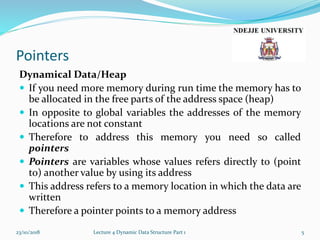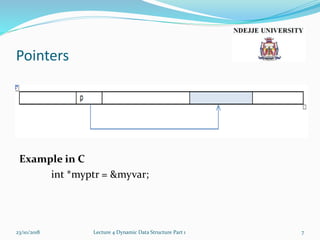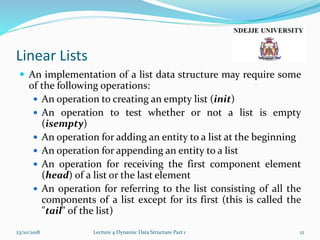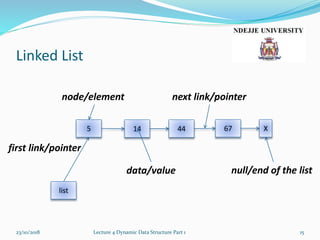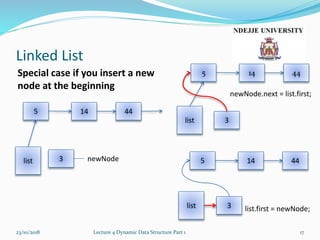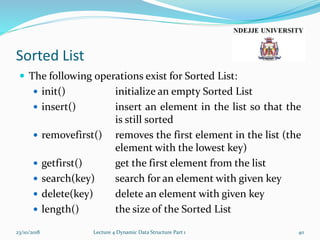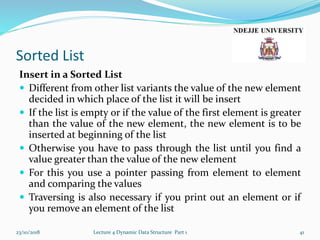Lecture4a dynamic data_structure
- 1. Lecture 4 Dynamic Data Structure Part 1 23/10/2018 Lecture 4 Dynamic Data Structure Part 1 1
- 2. Content Lecture 4 Dynamic Data Part 1 Pointer Linear Lists Linked List Circular List Doubly-Linked List Stack Queues Sorted List Linked Lists vs. Dynamic Arrays 23/10/2018 Lecture 4 Dynamic Data Structure Part 1 2
- 3. Pointers Pointers are an essential instrument in dynamical data structures But the use of pointers is not trivial That is because of: //important Technics working with pointer are hard to read The chances for errors are higher (especially for beginners) Undefined pointers are causing the most program crashes 23/10/2018 Lecture 4 Dynamic Data Structure Part 1 3
- 4. Pointers Address space When a program is executed the data are placed in the memory You can see the memory as an array which elements are memory cells The index area of this array is called address space The single memory cell is in general one byte (8 bits) Each active program has its own virtual address space This space consists of a heap and a stack Local variable or constants are stored in the stack 23/10/2018 Lecture 4 Dynamic Data Structure Part 1 4
- 5. Pointers Dynamical Data/Heap If you need more memory during run time the memory has to be allocated in the free parts of the address space (heap) In opposite to global variables the addresses of the memory locations are not constant Therefore to address this memory you need so called pointers Pointers are variables whose values refers directly to (point to) another value by using its address This address refers to a memory location in which the data are written Therefore a pointer points to a memory address 23/10/2018 Lecture 4 Dynamic Data Structure Part 1 5
- 6. Pointers 23/10/2018 Lecture 4 Dynamic Data Structure Part 1 6 Storage for dynamical data created or initialized at runtime Storage for local variables and parameters declared and initialized before runtime
- 7. Pointers Example in C int *myptr = &myvar; 23/10/2018 Lecture 4 Dynamic Data Structure Part 1 7
- 8. Pointers More than one pointer can refer to the same memory location In program language pointers are often used to realize a call-by-reference function call, also for lists, strings, lookup tables, control tables and trees You can still change the data behind the pointer If a pointer references to a location in memory to obtain the value at this location this is called dereferencing To release the memory you have to deallocate the memory In some program language the deallocation of the memory is done by a so called Garbage Collector (for example Java) 23/10/2018 Lecture 4 Dynamic Data Structure Part 1 8
- 9. Pointers In other language the programmer has to take care of the deallocation by himself (for example C/C++) That leads to following problems: The deallocation can be forgotten (memory leaks) It is not always trivial to calculate what and when something has to be deallocated Pointers are still used even when the deallocation has taken place (dangling reference) All this problems can lead to a mostly unexpected behavior of the program execution 23/10/2018 Lecture 4 Dynamic Data Structure Part 1 9
- 10. Linear Lists To one of the simplest data structure belongs the Linear List A number of elements ai are represented in an order form: a1 a2 … ai-1 ai ai+1 … an Typical operations are: Putting a new element at the beginning or at the end of the list Deleting an element from the list Getting an element at position i (especially when i=1 or i=n) Getting the next or previous element of an element ai (therefore ai+1 or ai-1) 23/10/2018 Lecture 4 Dynamic Data Structure Part 1 10
- 11. Linear Lists Examples for lists Orders in a shop: Each element is equal to an order. The order tells which article has to be send to a costumer. Each new order is put at the end of the list. After finishing the order the element is deleted in the list. Moves: Each element is equal to a move in a game. A new move is put at the end of the list. You can restore an old score by removing the last element. Timetable: Each element is equal to a new appointment or short information. All elements are sorted by time. New entries are therefore put in the list according to their time. Expired entries are deleted from the list. 23/10/2018 Lecture 4 Dynamic Data Structure Part 1 11
- 12. Linear Lists An implementation of a list data structure may require some of the following operations: An operation to creating an empty list (init) An operation to test whether or not a list is empty (isempty) An operation for adding an entity to a list at the beginning An operation for appending an entity to a list An operation for receiving the first component element (head) of a list or the last element An operation for referring to the list consisting of all the components of a list except for its first (this is called the "tail" of the list) 23/10/2018 Lecture 4 Dynamic Data Structure Part 1 12
- 13. Linked List A Linked List is a data structure that consists of a sequence of data records such that in each record there is a field that contains a reference (a link) to the next record in the sequence Each record of a Linked List is often called an element or node The field of each node that contains the address of the next node is usually called the next link or next pointer The remaining fields are known as the data, information or value 23/10/2018 Lecture 4 Dynamic Data Structure Part 1 13
- 14. Linked List struct Node { data; //The data/value being stored in the node Node next; //reference to the next node, null for last //node }; struct List { Node first; //Points to first node of list; null for empty //list }; 23/10/2018 Lecture 4 Dynamic Data Structure Part 1 14
- 15. Linked List 23/10/2018 Lecture 4 Dynamic Data Structure Part 1 15 5 14 44 67 X node/element next link/pointer data/value null/end of the list list first link/pointer
- 16. Linked List 23/10/2018 Lecture 4 Dynamic Data Structure Part 1 16 5 14 44 67 X 31 5 14 44 67 X 31 Insert a new node 5 14 44 67 X 31 newNode.next newNode.next = node.next node.next = newNode newNode node node.next
- 17. Linked List 23/10/2018 Lecture 4 Dynamic Data Structure Part 1 17 5 14 44 3list newNode 5 14 44 3list newNode.next = list.first; Special case if you insert a new node at the beginning 5 14 44 3list list.first = newNode;
- 18. Linked List Removing a node 23/10/2018 Lecture 4 Dynamic Data Structure Part 1 18 5 14 44 67 5 14 44 67 node obsoleteNode node.next 5 14 44 67 node.next node.next.next destroy obsoleteNode node.next = node.next.next;
- 19. Linked List 23/10/2018 Lecture 4 Dynamic Data Structure Part 1 19 5 14 44 list 5 14 44 list 5 14 44 list obsoleteNode = list.first list.first = list.first.next list.first.next destroy obsoleteNode Removing a node in front of the list
- 20. Circular List In the most cases the last node of a list contains a null value Means that there is no next node in the list In some cases a pointer to the first node of the list is made This is called a Circular List 23/10/2018 Lecture 4 Dynamic Data Structure Part 1 20 5 14 44 67 struct List { Node first; //Points to first node of list; Node last; //Points to first node of list; }
- 21. Circular List Insert an element at the beginning newNode.next = list.first list.first = newNode list.last = newNode; 23/10/2018 Lecture 4 Dynamic Data Structure Part 1 21 5 14 44 67 1 5 14 44 67 1
- 22. Doubly-Linked List A Doubly-Linked List is a Linked List that contains a number of elements, each having two special fields referencing to the next and previous element in the list You can view it as two Linked Lists formed from the same data items, in two opposite directions 23/10/2018 Lecture 4 Dynamic Data Structure Part 1 22 5 14 44 67 XX
- 23. Doubly-Linked List struct Node { data; // The data being stored in the node Node next; // A reference to the next node; null for last node Node prev; // A reference to the previous node; null for first // node }; struct List { Node firstNode; // points to first node of list; Node lastNode; // points to last node of list; }; 23/10/2018 Lecture 4 Dynamic Data Structure Part 1 23
- 24. Doubly-Linked List Iterating through a Doubly Linked List can be done in either direction In fact, direction can change many times, if desired Forwards node = list.firstNode while (node != null) { //do something with the //data node = node.next; } 23/10/2018 Lecture 4 Dynamic Data Structure Part 1 24 Backwards node = list.lastNode while (node != null) { //do something with the //data node = node.prev; }
- 25. Doubly-Linked List Inserting a node 23/10/2018 Lecture 4 Dynamic Data Structure Part 1 25 5 14 44 67 XX 31 5 14 44 67 XX 31 newNode newNode.prev = node; newNode.next = node.next; node
- 26. Doubly-Linked List 23/10/2018 Lecture 4 Dynamic Data Structure Part 1 26 5 14 44 67 XX 31 5 14 44 67 XX 31 node.next = newNode; node.next.prev = newNode
- 27. Doubly-Linked List 23/10/2018 Lecture 4 Dynamic Data Structure Part 1 27 Removing a node 5 14 44 67 XX 5 14 44 67 XX 5 14 67 XX destroy node; obsoleteNode obsoleteNode.prev.next=obsoleteNode.next; 44 obsoleteNode.next.prev=obsoleteNode.prev;
- 28. Stack A Stack is also a Linear List with the difference that only at one end elements could be added or removed In a Stack you are mostly interested in the element on the top Elements below are only appearing again if all elements on the top of it are removed In computer science, a stack is a Last In, First Out (LIFO) abstract data type and data structure Examples for Stacks: Game Tic-Tac-Toe 23/10/2018 Lecture 4 Dynamic Data Structure Part 1 28
- 29. Stack In the most program language the implementation of Stack can be done with arrays The C++ Standard Template Library provides a Stack Template Class which is restricted to only push/pop operations Java's library contains a Stack class that is a specialization of the class Vector 23/10/2018 Lecture 4 Dynamic Data Structure Part 1 29
- 30. Stack An implementation of a Stack may require some of the following operations: An operation to creating an empty Stack (init) An operation to add an element on the top of the Stack (push) An operation to remove an element on the top of the Stack (pop) An operation to receive the current element on the top of the Stack (top) An operation to receive the length of the stack; the number of elements in the Stack (length) An operation showing that the maximal capacity of the Stack is reached (full) 23/10/2018 Lecture 4 Dynamic Data Structure Part 1 30
- 31. Stack Example X = {1, 3, 5, 7, 11, 13} a Stack length() = 6 pop() = 13 X = {1, 3, 5, 7, 11} top() = 11 length() = 5 push(17); X = {1, 3, 5, 7, 11, 17} length() = 6 top() = 17 23/10/2018 Lecture 4 Dynamic Data Structure Part 1 31 13 11 7 5 3 1 11 7 5 3 1 17 11 7 5 3 1
- 32. Stack Example X = {b, d, f, h, j, l, n, p} a Stack What is: pop() length() top() push(r) length() top() 23/10/2018 Lecture 4 Dynamic Data Structure Part 1 32
- 33. Stack Solution X = {b, d, f, h, j, l, n, p} a Stack What is: pop() X = {b, d, f, h, j, l, n} length() = 7 top() = n push(r) X = {b, d, f, h, j, l, n, r} length() = 8 top() = r 23/10/2018 Lecture 4 Dynamic Data Structure Part 1 33 p n l j h f d b r n l j h f d b n l j h f d b
- 34. Queues A Queue or FIFO (First-In-First-Out) is a Linear List where at one end elements are added and on the other end elements are removed The inner elements are not considered The elements will be processed in exactly the same order in which they are original placed The C++ Standard Template Library provides a Queue Template Class. 23/10/2018 Lecture 4 Dynamic Data Structure Part 1 34
- 35. Queues The following operations exists in general for queues init() initialize an empty queue isempty() true if the queue is empty, otherwise false pop() removes the item at the front of the queue push() insert an item at the back of the queue size() return the number of elements in the queue front() returns a reference to the value at the front of a non-empty queue 23/10/2018 Lecture 4 Dynamic Data Structure Part 1 35
- 36. Queues Example Y = {1, 3, 5, 7, 11, 13} a Queue isempty() = false pop() = 13 Y = {1, 3, 5, 7, 11} push(17) Y = {17, 1, 3, 5, 7, 11} size() = 6 front() = 11 23/10/2018 Lecture 4 Dynamic Data Structure Part 1 36 1 3 5 7 11 13 17 1 3 5 7 11 1 3 5 7 11
- 37. Queues Example Y = {g, f, e, d, c, b, a} a Queue What is pop() size() front() push(h) isempty() size() 23/10/2018 Lecture 4 Dynamic Data Structure Part 1 37 g f e d c b a
- 38. Queues Solution Y = {g, f, e, d, c, b, a} a Queue What is pop() = a Y = {g, f, e, d, c, b} size() = 6 front() = b push(h) Y = {h, g, f, e, d, c, b} isempty() = false size() = 7 23/10/2018 Lecture 4 Dynamic Data Structure Part 1 38 g f e d c b a g f e d c b h g f e d c b
- 39. Sorted List In a Sorted List each element has a key For this key a complete order relation ≤ exists with: a ≤ a (reflexivity) a ≤ b and b ≤ a a = b (anti symmetry) a ≤ b and b ≤ c a ≤ c (transitivity) With this order relation you can decided if an element is smaller or bigger than another one 23/10/2018 Lecture 4 Dynamic Data Structure Part 1 39
- 40. Sorted List The following operations exist for Sorted List: init() initialize an empty Sorted List insert() insert an element in the list so that the is still sorted removefirst() removes the first element in the list (the element with the lowest key) getfirst() get the first element from the list search(key) search for an element with given key delete(key) delete an element with given key length() the size of the Sorted List 23/10/2018 Lecture 4 Dynamic Data Structure Part 1 40
- 41. Sorted List Insert in a Sorted List Different from other list variants the value of the new element decided in which place of the list it will be insert If the list is empty or if the value of the first element is greater than the value of the new element, the new element is to be inserted at beginning of the list Otherwise you have to pass through the list until you find a value greater than the value of the new element For this you use a pointer passing from element to element and comparing the values Traversing is also necessary if you print out an element or if you remove an element of the list 23/10/2018 Lecture 4 Dynamic Data Structure Part 1 41
- 42. Sorted List Example 23/10/2018 Lecture 4 Dynamic Data Structure Part 1 42 5 14 44 67 XX 22 5 14 44 67 XX 22 1. 5 < 22 2. 14 < 22 3. 44 > 22
- 43. Any questions? 23/10/2018 Lecture 4 Dynamic Data Structure Part 1 43
Editor's Notes
- #10: Garbage Collector: daemon process running in the background




